Rendezvous with The Ancient Kingdom of Polonnaruwa
|
Read. Imagine. Travel.
Namaste! We are pleased to inform you Sri Lanka is back on the touristic map and is welcoming guests again. In the last few months, Sri Lanka had some difficulties due to the recent economic crisis, but due to the global and Sri Lankan Government's efforts, things are gradually going back to normal. In the past, people faced difficulties due to lack of fuel and other energy sources. However, now there is no gas shortage. Fuel distribution is also back to normal, and daily power outages have also come down to the bare minimum. In most of the areas, the power outage has come down to a maximum of 1 hour per day.
According to the data issued by the Sri Lankan Government, Sri Lanka welcomed 38,000 tourists in August 2022.
With this great news, why not talk a bit more about Sri Lanka. Therefore, in this edition of TravNama, we will take you to Polonnaruwa, one of the most beautiful UNESCO Heritage Sites in Sri Lanka.
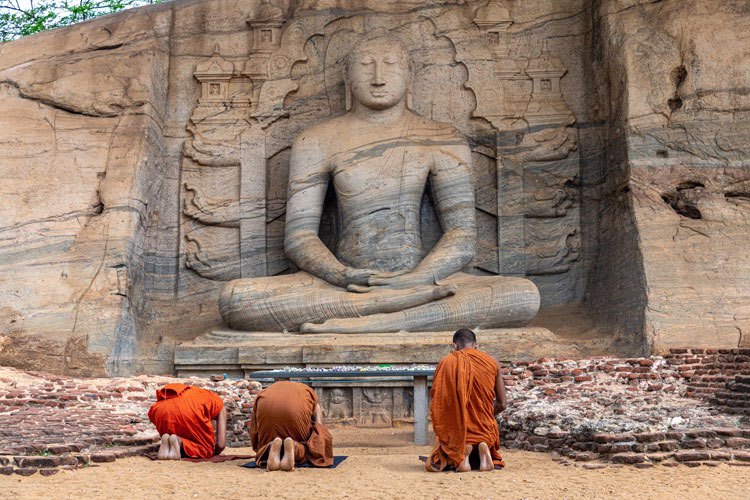
Polonnaruwa was the second capital of Ancient Sri Lanka. From Polonnaruwa, Kings ruled the central plains of Sri Lanka around 800 years ago. This majestic land was once a thriving commercial and religious centre. The glories of that past are depicted in the archaeological treasures that still give a pretty good idea of how the city looked in its heyday. Watch the beauty of Polonnaruwa in this short video.
History of Polonnaruwa
After the destruction of Anuradhapura in 993 CE, the great King Vijay Vahu 1 founded Polonnaruwa in 1070 CE. Polonnaruwa became the second capital of ancient Sri Lanka. Under the rulership of the great King Parakramabahu I, Polonnaruwa flourished at its best. Today, impressions of the great Parakramabahu are visible all over the city.
Polonnaruwa lies close to the Parakrama Samudra, a large manmade lake. This lake is huge even though you can only see a part of it from the road. A huge part of this lake lies behind the hills of central Sri Lanka. Polonnaruwa once had an exceptional agricultural economy. The water management systems that followed here were said to be unmatched. Many folklores sung here say that in Polonnaruwa, not a single drop of rainwater was wasted. As per the folklore, Parakrambahu started trading with other kingdoms, and he built most of what you see today in and around the ancient city.
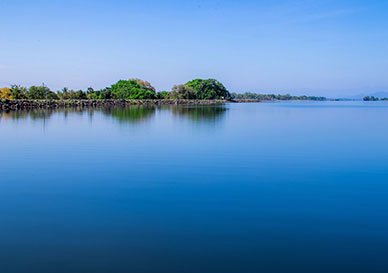 Nissankamalla, a king from Odisha in India, took the throne from King Parakramabahu. The legend says that he could become the King of Polonnaruwa as he belonged to a royal lineage as King Parakrambahu. King Nissankamalla was not shown respect as his predecessors, since he did not give the importance to the local aristocrats & landowners that they deserved. So, in the 9th year of his regime, the King was poisoned which led to his death. Later, when his son became the King, he was also murdered the same day he was crowned. This angered King Magh, Brother of King Nissankamalla. He came all the way from Odisha and destroyed the whole city in an act of revenge.
Nissankamalla, a king from Odisha in India, took the throne from King Parakramabahu. The legend says that he could become the King of Polonnaruwa as he belonged to a royal lineage as King Parakrambahu. King Nissankamalla was not shown respect as his predecessors, since he did not give the importance to the local aristocrats & landowners that they deserved. So, in the 9th year of his regime, the King was poisoned which led to his death. Later, when his son became the King, he was also murdered the same day he was crowned. This angered King Magh, Brother of King Nissankamalla. He came all the way from Odisha and destroyed the whole city in an act of revenge.
After this, the city could not see a strong King, followed by internal feuds leading to the decline of the mighty kingdom.
|
Ancient City – Polonnaruwa
The magnificent planning of Polonnaruwa made this city very unique. Polonnaruwa gives a comprehensive insight into how well planned the cities were during that period. Polonnaruwa city is divided into three main parts as mentioned below:
Inner City: The inner city was for accommodating the royals and their families. The inner city also housed the highest ranking officials of Polonnaruwa. The inner city had a beautiful palace and a gathering hall for the council members.
Outer City: It is the city where the tooth relic of Buddha was kept. The Outer City is perhaps the most beautiful part of these ancient ruins.
The Outermost city or the Northern City: This space was mostly occupied by the general public and the monks. Legends say that the monks living here were away from the power but were close to the common public, who fed them daily.
At the southernmost end of the Northern City was a library and the imposing statue of the Great King Parakramabahu.
Even today, when someone visits these partitions, they can distinctly see the three parts of the city but more or less in ruins. The entire place is in close quarters, and if the weather permits, one can easily cover these places on foot.
Archaeological Museum
At the Archaeological Museum, visitors need to buy tickets for visiting the ruins. The Archaeological Museum has kept one of the magnificent illustrative models of how the kingdom looked like in the 12th century. They also have many images depicting the condition of several monuments before and after the restoration works were completed.
 Here one can see the royal announcement of King Nissankamalla, who led the destruction of this great city. This illustration says that farmers should farm and should not try to become kings. Kings are gods in human form. Farmers trying to become a king are like a crow who is trying to become a swan.
Here one can see the royal announcement of King Nissankamalla, who led the destruction of this great city. This illustration says that farmers should farm and should not try to become kings. Kings are gods in human form. Farmers trying to become a king are like a crow who is trying to become a swan.
Polonnaruwa Inner City
The inner city is where the King and royal family lived. It was one of the most guarded parts of Polonnaruwa. It had a high brick wall all around it, that one can see even today.
Satmahal Prasada – The Royal Palace
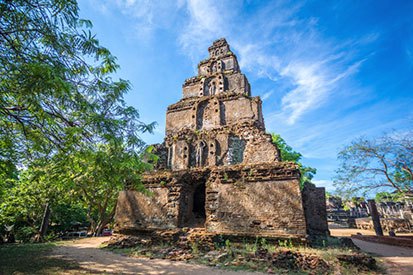 The Royal Palace, which now is in ruins, must have been a sight to see during its glorious days. Its remains have a double storied brick wall. Today, while visiting this ruined Palace, one will notice holes in the brick wall. It is believed that these holes might have been used to insert beams to hold the roof. The Palace is not huge, but it looked like it was built after a lot of planning.
The Royal Palace, which now is in ruins, must have been a sight to see during its glorious days. Its remains have a double storied brick wall. Today, while visiting this ruined Palace, one will notice holes in the brick wall. It is believed that these holes might have been used to insert beams to hold the roof. The Palace is not huge, but it looked like it was built after a lot of planning.
This majestic palace was destroyed and burnt by the invaders. The story of the destruction is still visible in the form of burning marks on the remains of the Palace.
Council Hall
The Council Hall is a rectangular building, which was built on a raised platform. The most beautiful part of what is remaining of it is the steps that lead to the hall. On the two sides of the steps, lion statues guard the steps. There is a bas relief of elephants, which can be seen running across the platform wall with each elephant carved differently.
When you climb up the platform, you see free-standing pillars. At the end of the platform, there is a royal seat of the great Kings of this beautiful capital. I presume the Ministers might have sat on each side of the platform during meetings and public audiences.
Royal Baths or Kumara Pokuna
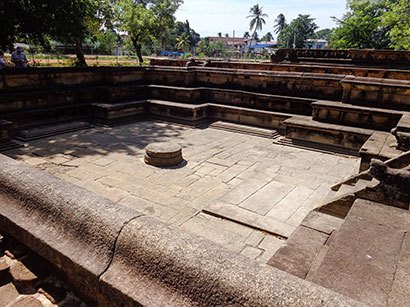 Royal Bath, or Kumara Pokuna, is a bathing pond with a chamber that would be equivalent to a changing room. The layered stone pond looks very similar to the Twin Ponds found in Anuradhapura. If you want to imagine the glory of this Royal Bath, close your eyes and imagine it filled with flowers and perfumed water. Heavenly right? It is said that in the Royal Bath, there was a provision for a shower!
Royal Bath, or Kumara Pokuna, is a bathing pond with a chamber that would be equivalent to a changing room. The layered stone pond looks very similar to the Twin Ponds found in Anuradhapura. If you want to imagine the glory of this Royal Bath, close your eyes and imagine it filled with flowers and perfumed water. Heavenly right? It is said that in the Royal Bath, there was a provision for a shower!
Outer City
This part is better known as the Quadrangle, where the Tooth Relic of Buddha rested during the Polonnaruwa Era
Vatadage
 The Vatadage is one of the most beautiful sites to visit in Sri Lanka. A vatadage is a raised platform with a circular wall with an opening in four main points of a compass: north, south, east, and west. There is a statue of Buddha on top. To reach the platform, there is a small flight of steps. Like everywhere else in Polonnaruwa, the steps here are also beautifully carved with lion heads.
The Vatadage is one of the most beautiful sites to visit in Sri Lanka. A vatadage is a raised platform with a circular wall with an opening in four main points of a compass: north, south, east, and west. There is a statue of Buddha on top. To reach the platform, there is a small flight of steps. Like everywhere else in Polonnaruwa, the steps here are also beautifully carved with lion heads.
Nissanka Lata Mandapa
Next is the Nissanka Lata Mandapa. The pillars are not straight but carved as a stalk of Lotus stem or like a vine. These are sculptures of rare beauty and class. As the name suggests, they were built by King Nissanka Malla. There is a dagaba or stupa in the middle of this sacred hall.
Hatadage
 Right opposite the Vatadaga lies this beautiful shrine. It once was home to the tooth relic temple. The first King of Polonnaruwa- the great King Vijaybahu I built this shrine. What remains today are the pillars and the base with a lone Buddha statue standing.
Right opposite the Vatadaga lies this beautiful shrine. It once was home to the tooth relic temple. The first King of Polonnaruwa- the great King Vijaybahu I built this shrine. What remains today are the pillars and the base with a lone Buddha statue standing.
Gal Potha or the Stone Book
The Stone Book is by far one of the most intriguing parts of this sacred Quadrangle. The Stone Book is actually a long ancient inscription, but it will look like a giant book if you are looking at it from a distance. Such is the beauty of creation!
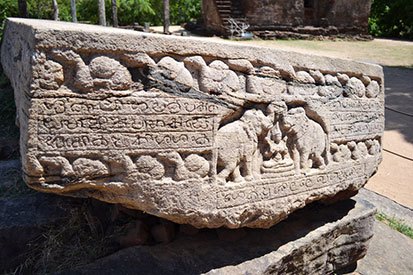 There is a board next to Gal Potha that explains this ancient inscription. The inscription says the stone block was brought from Mihintale, a sacred place around 98 km away from this site. It further talks about King Vijaybahu and his Kalinga origins. It narrates the story of how King Vijaybahu became the King. It further gives an insight into how he reduced the taxes based on the distance of fields from the water source.
There is a board next to Gal Potha that explains this ancient inscription. The inscription says the stone block was brought from Mihintale, a sacred place around 98 km away from this site. It further talks about King Vijaybahu and his Kalinga origins. It narrates the story of how King Vijaybahu became the King. It further gives an insight into how he reduced the taxes based on the distance of fields from the water source.
It further talks about the repair works the King carried out at several stupas and the new structures he built. It talks about his alliance with many Kingdoms of India. It also talks about the great characters of the King. How he donated things worth his, his wife’s, and his children's weight daily.
Lastly, the inscription says that the Kalingas were the rightful heirs of this island nation's throne. Therefore, any non-Buddhist king like Pandyas of the South Indian Kingdom shall not be crowned as kings in Sri Lanka.
Northern City in ruins
This is where one can see the remains of monasteries, hospitals, markets, cemeteries, and other common public places. Some villages surrounded the city, where most of the general public would have lived. Interestingly one of the biggest monasteries in the Northern Ruin is built on the site of a cemetery.
Ran Kot Vihara
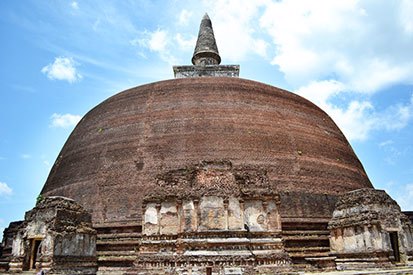 Ran Kot Vihara is a golden pinnacle brick dagaba or a stupa. It was built by the great King Nissankamalla and is said to be the largest structure in Polonnaruwa. The Rankoth Vihara is said to be built under the tradition of the stupas of the Anuradhapura Maha Viharaya and bears a close similarity to the most sacred Ruwanwelisaya. The inscriptions here say that the structure was called Ruwanweli. Ran in Sinhalese means gold and the Ran Kot Vihara roughly translates to "Gold Pinnacled Stupa."
Ran Kot Vihara is a golden pinnacle brick dagaba or a stupa. It was built by the great King Nissankamalla and is said to be the largest structure in Polonnaruwa. The Rankoth Vihara is said to be built under the tradition of the stupas of the Anuradhapura Maha Viharaya and bears a close similarity to the most sacred Ruwanwelisaya. The inscriptions here say that the structure was called Ruwanweli. Ran in Sinhalese means gold and the Ran Kot Vihara roughly translates to "Gold Pinnacled Stupa."
Gal Vihara
Gal Vihara is a small group of rock-cut Buddha images. If you look at them closely, they have striking similarities to the Bamiyan Buddha statues in Afghanistan, which sadly are destroyed. Watch the serenity of Lord Buddha has been portrayed perfectly by skilful, ancient Sri Lankan artists at Gal Viharaya in this short video.
Southern End of the ruins: In the Southern End of the ruins lies Maha Parakramabhau Statue and Pothgul Vihara.
Maha Parakramabahu Statue
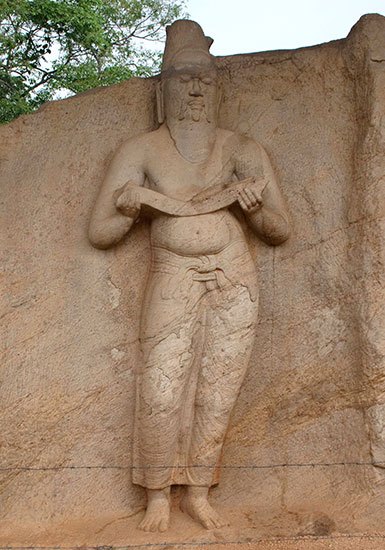 Around 3 km south of the Inner Citadel is the Potgul Vihara. To reach here, one will have to walk through the rocky path that leads to the statue of the great King Parakramabahu. The statue of King Parakramabahu has part of a plough in one of his hands. There is no evidence or any inscription stating what this statue depicts. However, the local folklore says that the statue is of their great King. It further says that the statue depicts the beginning of the harvesting season and a ceremony that the King would perform.
Around 3 km south of the Inner Citadel is the Potgul Vihara. To reach here, one will have to walk through the rocky path that leads to the statue of the great King Parakramabahu. The statue of King Parakramabahu has part of a plough in one of his hands. There is no evidence or any inscription stating what this statue depicts. However, the local folklore says that the statue is of their great King. It further says that the statue depicts the beginning of the harvesting season and a ceremony that the King would perform.
The statue depicts the great King as a common man but still has a royal stance. Some of the experts differ and say that the sculpture is of a sage and not a King.
Pothgul Vihara
A few meters south of the Maha Parakramabahu Statue is an elegant building with a circular chamber right at the centre. This beautiful building was once the ancient library. Some narratives state that this was some kind of an auditorium or a place to listen to stories. Witness the architectural marvel in Rothgul Vihara in this short video.
Polonnaruwa is by far one of the best places to witness history at its best. The roads, the ruins, and the architecture still sing the glory of the second capital of Sri Lanka. So if you are planning a trip to Sri Lanka, be sure to include Polonnaruwa in your travel plans. At Indo Asia Tours, the itinerary is not just a travel route or a trip. We design, conceptualize and handcraft every journey for you. Our special customized itineraries and curated experiences in different destinations are what make for those memorable travel moments.
|
Virtual Destination Training Program
|
 Thank you, patrons, for reposing faith in our destinations and enquiring for customised virtual destination awareness training programs. We are proud to conduct them successfully so far and are looking forward to hold similar virtual destination awareness training programs for your team or yourself or a virtual tour for your clients. Let us know the destination of your interest along with your convenient date / time and we will be happy to set up a program for you.
Thank you, patrons, for reposing faith in our destinations and enquiring for customised virtual destination awareness training programs. We are proud to conduct them successfully so far and are looking forward to hold similar virtual destination awareness training programs for your team or yourself or a virtual tour for your clients. Let us know the destination of your interest along with your convenient date / time and we will be happy to set up a program for you.
Send Request
|
Please feel free to write back to us at marketing@indoasiatours.com to share our thoughts on customized journeys covering the Indian subcontinent or take time to visit our website https://www.indoasia-tours.com. Be sure we will prepare the best program to make a memorable trip for your esteemed clients!
|
|


 Nissankamalla, a king from Odisha in India, took the throne from King Parakramabahu. The legend says that he could become the King of Polonnaruwa as he belonged to a royal lineage as King Parakrambahu. King Nissankamalla was not shown respect as his predecessors, since he did not give the importance to the local aristocrats & landowners that they deserved. So, in the 9th year of his regime, the King was poisoned which led to his death. Later, when his son became the King, he was also murdered the same day he was crowned. This angered King Magh, Brother of King Nissankamalla. He came all the way from Odisha and destroyed the whole city in an act of revenge.
Nissankamalla, a king from Odisha in India, took the throne from King Parakramabahu. The legend says that he could become the King of Polonnaruwa as he belonged to a royal lineage as King Parakrambahu. King Nissankamalla was not shown respect as his predecessors, since he did not give the importance to the local aristocrats & landowners that they deserved. So, in the 9th year of his regime, the King was poisoned which led to his death. Later, when his son became the King, he was also murdered the same day he was crowned. This angered King Magh, Brother of King Nissankamalla. He came all the way from Odisha and destroyed the whole city in an act of revenge.
 Here one can see the royal announcement of King Nissankamalla, who led the destruction of this great city. This illustration says that farmers should farm and should not try to become kings. Kings are gods in human form. Farmers trying to become a king are like a crow who is trying to become a swan.
Here one can see the royal announcement of King Nissankamalla, who led the destruction of this great city. This illustration says that farmers should farm and should not try to become kings. Kings are gods in human form. Farmers trying to become a king are like a crow who is trying to become a swan.
 The Royal Palace, which now is in ruins, must have been a sight to see during its glorious days. Its remains have a double storied brick wall. Today, while visiting this ruined Palace, one will notice holes in the brick wall. It is believed that these holes might have been used to insert beams to hold the roof. The Palace is not huge, but it looked like it was built after a lot of planning.
The Royal Palace, which now is in ruins, must have been a sight to see during its glorious days. Its remains have a double storied brick wall. Today, while visiting this ruined Palace, one will notice holes in the brick wall. It is believed that these holes might have been used to insert beams to hold the roof. The Palace is not huge, but it looked like it was built after a lot of planning.
 Royal Bath, or Kumara Pokuna, is a bathing pond with a chamber that would be equivalent to a changing room. The layered stone pond looks very similar to the Twin Ponds found in Anuradhapura. If you want to imagine the glory of this Royal Bath, close your eyes and imagine it filled with flowers and perfumed water. Heavenly right? It is said that in the Royal Bath, there was a provision for a shower!
Royal Bath, or Kumara Pokuna, is a bathing pond with a chamber that would be equivalent to a changing room. The layered stone pond looks very similar to the Twin Ponds found in Anuradhapura. If you want to imagine the glory of this Royal Bath, close your eyes and imagine it filled with flowers and perfumed water. Heavenly right? It is said that in the Royal Bath, there was a provision for a shower!
 The Vatadage is one of the most beautiful sites to visit in Sri Lanka. A vatadage is a raised platform with a circular wall with an opening in four main points of a compass: north, south, east, and west. There is a statue of Buddha on top. To reach the platform, there is a small flight of steps. Like everywhere else in Polonnaruwa, the steps here are also beautifully carved with lion heads.
The Vatadage is one of the most beautiful sites to visit in Sri Lanka. A vatadage is a raised platform with a circular wall with an opening in four main points of a compass: north, south, east, and west. There is a statue of Buddha on top. To reach the platform, there is a small flight of steps. Like everywhere else in Polonnaruwa, the steps here are also beautifully carved with lion heads.
 Right opposite the Vatadaga lies this beautiful shrine. It once was home to the tooth relic temple. The first King of Polonnaruwa- the great King Vijaybahu I built this shrine. What remains today are the pillars and the base with a lone Buddha statue standing.
Right opposite the Vatadaga lies this beautiful shrine. It once was home to the tooth relic temple. The first King of Polonnaruwa- the great King Vijaybahu I built this shrine. What remains today are the pillars and the base with a lone Buddha statue standing.
 There is a board next to Gal Potha that explains this ancient inscription. The inscription says the stone block was brought from Mihintale, a sacred place around 98 km away from this site. It further talks about King Vijaybahu and his Kalinga origins. It narrates the story of how King Vijaybahu became the King. It further gives an insight into how he reduced the taxes based on the distance of fields from the water source.
There is a board next to Gal Potha that explains this ancient inscription. The inscription says the stone block was brought from Mihintale, a sacred place around 98 km away from this site. It further talks about King Vijaybahu and his Kalinga origins. It narrates the story of how King Vijaybahu became the King. It further gives an insight into how he reduced the taxes based on the distance of fields from the water source.
 Ran Kot Vihara is a golden pinnacle brick dagaba or a stupa. It was built by the great King Nissankamalla and is said to be the largest structure in Polonnaruwa. The Rankoth Vihara is said to be built under the tradition of the stupas of the Anuradhapura Maha Viharaya and bears a close similarity to the most sacred Ruwanwelisaya. The inscriptions here say that the structure was called Ruwanweli. Ran in Sinhalese means gold and the Ran Kot Vihara roughly translates to "Gold Pinnacled Stupa."
Ran Kot Vihara is a golden pinnacle brick dagaba or a stupa. It was built by the great King Nissankamalla and is said to be the largest structure in Polonnaruwa. The Rankoth Vihara is said to be built under the tradition of the stupas of the Anuradhapura Maha Viharaya and bears a close similarity to the most sacred Ruwanwelisaya. The inscriptions here say that the structure was called Ruwanweli. Ran in Sinhalese means gold and the Ran Kot Vihara roughly translates to "Gold Pinnacled Stupa."
 Around 3 km south of the Inner Citadel is the Potgul Vihara. To reach here, one will have to walk through the rocky path that leads to the statue of the great King Parakramabahu. The statue of King Parakramabahu has part of a plough in one of his hands. There is no evidence or any inscription stating what this statue depicts. However, the local folklore says that the statue is of their great King. It further says that the statue depicts the beginning of the harvesting season and a ceremony that the King would perform.
Around 3 km south of the Inner Citadel is the Potgul Vihara. To reach here, one will have to walk through the rocky path that leads to the statue of the great King Parakramabahu. The statue of King Parakramabahu has part of a plough in one of his hands. There is no evidence or any inscription stating what this statue depicts. However, the local folklore says that the statue is of their great King. It further says that the statue depicts the beginning of the harvesting season and a ceremony that the King would perform.
 Thank you, patrons, for reposing faith in our destinations and enquiring for customised virtual destination awareness training programs. We are proud to conduct them successfully so far and are looking forward to hold similar virtual destination awareness training programs for your team or yourself or a virtual tour for your clients. Let us know the destination of your interest along with your convenient date / time and we will be happy to set up a program for you.
Thank you, patrons, for reposing faith in our destinations and enquiring for customised virtual destination awareness training programs. We are proud to conduct them successfully so far and are looking forward to hold similar virtual destination awareness training programs for your team or yourself or a virtual tour for your clients. Let us know the destination of your interest along with your convenient date / time and we will be happy to set up a program for you.




